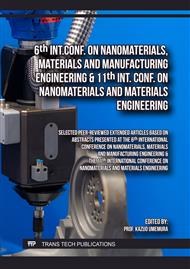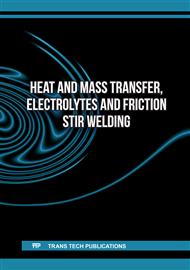[1]
M. Khedr, A. Hamada, A. Järvenpää, S. Elkatatny, W. Abd-Elaziem, Review on the Solid-State Welding of Steels: Diffusion Bonding and Friction Stir Welding Processes. Metals (2023).
DOI: 10.3390/met13010054
Google Scholar
[2]
C. Zhou, X. Yang, G. Luan, Investigation of microstructures and fatigue properties of friction stir welded Al–Mg alloy, Materials Chemistry and Physics 98 (2006) 285-290.
DOI: 10.1016/j.matchemphys.2005.09.019
Google Scholar
[3]
K.A. Prabha, P.S. Putha, B. S. Prasad, Effect of Tool Rotational Speed on Mechanical Properties Of Aluminium Alloy 5083 Weldments in Friction Stir Welding, Materials Today: Proceedings 5 (2018) 18535-18543.
DOI: 10.1016/j.matpr.2018.06.196
Google Scholar
[4]
N. Khan, S. Rathee, M. Srivastava, Friction stir welding: An overview on effect of tool variables, Materials Today: Proceedings 47 (2021) 7196-7202.
DOI: 10.1016/j.matpr.2021.07.487
Google Scholar
[5]
O.S. Salih, H. Ou, W. Sun, Heat generation, plastic deformation and residual stresses in friction stir welding of aluminium alloy, International Journal of Mechanical Sciences 238 (2023).
DOI: 10.1016/j.ijmecsci.2022.107827
Google Scholar
[6]
M. Türkan, Ö. Karakaş, Numerical modeling of defect formation in friction stir welding, Materials Today Communication 31 (2022).
DOI: 10.1016/j.mtcomm.2022.103539
Google Scholar
[7]
A. Ghiasvand, W. Suksatan, J. Tomków, G. Rogaiski, H. A. Derazkola, Investigation of the Effects of Tool Positioning Factors on Peak Temperature in Dissimilar Friction Stir Welding of AA6061-T6 and AA7075-T6 Aluminum Alloys, Materials (2022).
DOI: 10.3390/ma15030702
Google Scholar
[8]
R. Nandan, T. Debroy, H.K.D.H Bhadeshia, Recent advances in friction-stir welding – Process, weldment structure and properties, Progress in Materials Science 53 (2008).
DOI: 10.1016/j.pmatsci.2008.05.001
Google Scholar
[9]
P. Chauhan, R. Jain, S.K. Pal, S.B. Singh, Modeling of defects in friction stir welding using coupled Eulerian and Lagrangian method, Journal of Manufacturing Processes 34 (2018).
DOI: 10.1016/j.jmapro.2018.05.022
Google Scholar



